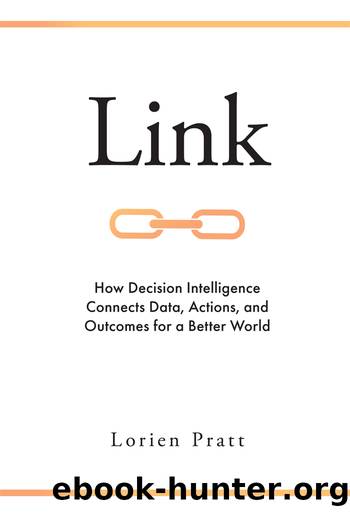Link by Lorien Pratt

Author:Lorien Pratt [Pratt, Lorien]
Language: eng
Format: epub
ISBN: 9781787696556
Publisher: Emerald Publishing Limited
Published: 2019-07-29T04:00:00+00:00
Source: Rick Ladd.
STATISTICS
Using evidence to make good decisions was traditionally the realm of the field of statistics. Today, statistics, AI, ML, and DI are deeply interwoven. Many ML techniques are based on statistical principles. Bayesian statistics are an important part of DI.
In general, statistical methods differ from AI by their focus on smaller data sets and their use of statistical assumptions as to the distribution of data. For instance, a statistical method might assume that the distribution of heights in a population follows a normal â or bell-shaped â curve. Using this assumption, a statistical method could draw reliable conclusions about an animalâs height given its weight from only a few examples of âheight, weightâ pairs of that animal.
In contrast, ML is often used for problems for which not as much can be assumed, and so it depends on a larger amount of data as a substitute for knowledge about data distribution. Since âBig Dataâ is now available in many arenas, this is today practical in a way that it wasnât in the past.
Another significant difference between statistical methods and AI is that AI is usually used retrospectively, meaning that a data set is gathered in advance of any experimental design, and then AI is used to identify patterns in that data. Statistical methods can be used proactively as well, such as when designing a Randomized Controlled Trial (RCT) to test the efficacy of a new medicine.
Relative to DI, most statistical methods provide single-link answers, just as ML does, as was explained in Chapter 1. So, a typical statistical question might be to address a single-link question like âIf I know a 10-year-old childâs IQ, how will that translate into their salary at age 25?â In contrast, DI concerns itself with whatâs the best action to take, given this answer. For instance, given that I know the relationship between IQ and salary, what are the consequences of various choices I may make about raising that child, such as the choice of their school?
Finally, statistics does not typically concern itself with the combination of expert knowledge and data. A typical decision model is based both on human expertise (for links where data are not available), and on links where data are available.5
A statistical subfield that deserves special mention in this context is Bayesian statistics â an old field that has been experiencing a resurgence in recent years [146]. The basic idea of Bayesian statistics is this: what is the likelihood that you have cancer, given that you are a woman over 50. We donât calculate the overall probability of cancer, but rather we calculate probabilities of sub-populations like this one. Another example: whatâs the likelihood of your revenue growing next year given that your competitors donât launch a new marketing campaign. Again, weâre asking not the overall probability but the probability conditional on some other situation holding.
Bayesian statistics is relevant to DI because thereâs a close relationship between propagating causation in the world and propagating probability (indeed, we might think of
Download
This site does not store any files on its server. We only index and link to content provided by other sites. Please contact the content providers to delete copyright contents if any and email us, we'll remove relevant links or contents immediately.
Hit Refresh by Satya Nadella(8996)
The Compound Effect by Darren Hardy(8736)
Change Your Questions, Change Your Life by Marilee Adams(7567)
Nudge - Improving Decisions about Health, Wealth, and Happiness by Thaler Sunstein(7461)
The Black Swan by Nassim Nicholas Taleb(6948)
Deep Work by Cal Newport(6820)
Daring Greatly by Brene Brown(6369)
Rich Dad Poor Dad by Robert T. Kiyosaki(6319)
Principles: Life and Work by Ray Dalio(6132)
Man-made Catastrophes and Risk Information Concealment by Dmitry Chernov & Didier Sornette(5878)
Playing to Win_ How Strategy Really Works by A.G. Lafley & Roger L. Martin(5776)
Digital Minimalism by Cal Newport;(5588)
Big Magic: Creative Living Beyond Fear by Elizabeth Gilbert(5557)
The Myth of the Strong Leader by Archie Brown(5375)
The Slight Edge by Jeff Olson(5316)
Discipline Equals Freedom by Jocko Willink(5241)
The Motivation Myth by Jeff Haden(5125)
Stone's Rules by Roger Stone(4989)
The Laws of Human Nature by Robert Greene(4927)
